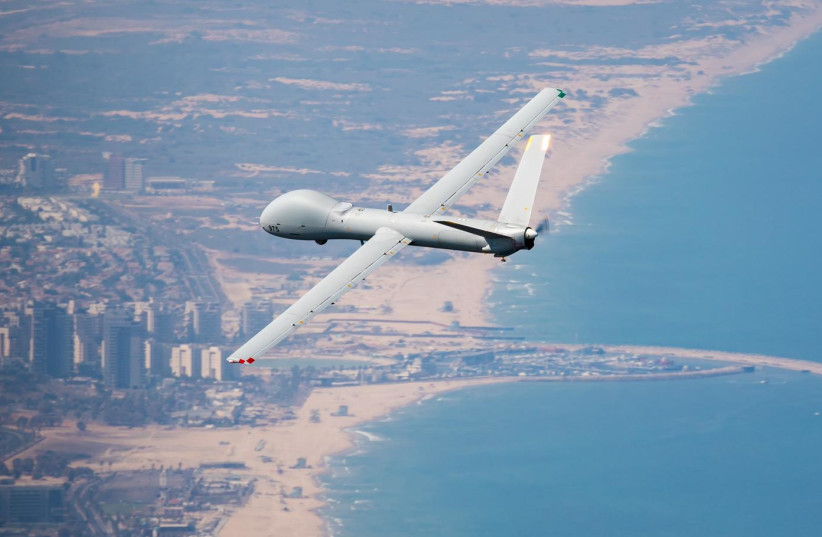The Iron Swords Operation is likely the first war of drones and small unmanned aerial vehicles in regional and possibly global military history. Images from yesterday showing the IDF's drone battle against a squad of three terrorists in Tulkarm a few days ago illustrate the extensive use of technology that once seemed like science fiction or a feature of a video game.
The IDF extensively uses drones and small aerial vehicles as part of its operational doctrine in Gaza, Judea and Samaria, and the northern border, saving the lives of dozens, if not more, soldiers. According to operational doctrine, a drone scans every space before a force enters. This includes the narrow alleys of Jabaliya and Nusirat, the buildings and homes in Khan Yunis and Gaza City neighborhoods, and even tunnel entrances.
Drones have become another tool in the hands of a company commander or team leader. Every combat force today has a drone operator who is part of the force's leading squad. These drones are scanning drones, and during the fighting, the IDF acquired a large number of devices capable of flying in dense areas, entering small spaces, and transmitting back images, including in poor visibility conditions and at night. Simultaneously, during the war, the IDF's counter-terrorism school established a program to train soldiers as drone pilots. Soldiers from all infantry brigades, the armored corps, combat engineering, commando units, and the IDF's tactical brigade undergo training to operate these tools on the battlefield.
Additionally, the IDF operates drones and unmanned aerial vehicles of varying sizes and flight ranges for reconnaissance, scanning, and attack purposes.

A pioneer in the development of UAVs
Israel is a pioneer in the development and use of unmanned aerial vehicles. This began precisely 50 years ago, following lessons from the Yom Kippur War. The IDF then operated a light squadron required to coordinate the IDF's artillery to hit the Egyptian army's positions across the canal and in the Sinai Peninsula. The squadron suffered hits from the Egyptian air defense system. Thus, it was decided to establish a UAV squadron—a small unmanned aircraft operated from a mobile launcher installed on a military truck and landed on a regular air force runway.
The first use of these tools was in the First Lebanon War in 1982. Since then, unmanned aerial vehicles have become a hallmark of the Israeli Air Force and all Western air forces.
The enemy also uses small aerial vehicles and drones. "They operate several types of small aerial vehicles and drones, ranging from the simplest, which are essentially small model airplanes made of styrofoam or lightweight wood, attached to a tiny engine, and even a small warhead or explosive grenade, and launch them at our forces," says an IDF source. "Such a tool can be purchased on any online sales site and costs just a few dozen dollars," says the IDF, explaining the complexity of dealing with the threat. According to IDF sources, this is a tactical weapon with limited damage scope, but its detection and interception capabilities are challenging due to its size and low radar signature. "It's like spotting a bird and intercepting it in flight," says an IDF source.
Another group of drones operated by Hezbollah and Hamas are drop drones. These drones can carry ammunition, usually grenades or warheads of mortar bombs, fly over a target, drop the grenade or bomb, and cause damage. Additionally, suicide UAVs, some manufactured in Iran, are deployed. They fly at speeds of up to 250 km/h and explode on the target, a kind of guided missile for the poor.
The IDF has developed several ways to defend against this threat. Among other things, shelters were quickly built over tank turrets, providing protection for tank commanders sitting in the turret and other crew members.
Simultaneously, in MAFAT (Israel’s Administration for the Development of Weapons and Technological Infrastructure), the Northern Command, Home Front Command, the Ground Forces, and the Air Force, efforts are being made to find solutions to this threat and implement them now on the battlefields in Gaza, the north, and Judea and Samaria.
Additionally, it is estimated that the Defense Ministry's laser system, which will be operational in about a year and a half, will provide a broader solution to the threat. The Defense Ministry is also working with Elbit Systems to develop an aerial laser system that will be installed on aircraft or UAVs, providing a complementary solution to the drone and UAV threat. However, completing the development will take about three to four and a half years.
